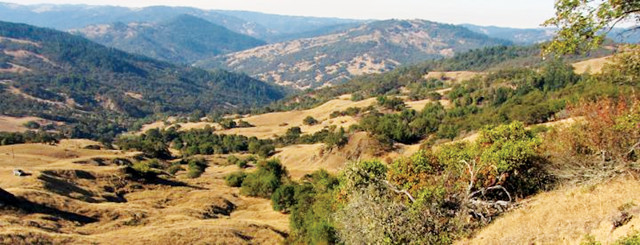
by Mary Caperton Morton Tuesday, September 13, 2016

The Eel River Basin is home to hundreds of slow-moving landslides, some of which have all but stopped because of California's ongoing drought. Credit: Georgina Bennett.
Most people think of landslides as fast-moving events, but many slides creep slowly, advancing over hundreds or thousands of years. In a new study, researchers looking at creeping landslides in California have revealed an unexpected consequence of the state’s ongoing drought: Many of the slides have nearly stopped due to the lack of water in the soil.
The Eel River Basin in Northern California is home to hundreds of slow-moving landslides that have been creeping downhill by tens of centimeters a year for thousands of years. Using a combination of on-the-ground measurements, aerial and satellite photography, and satellite-radar imaging, a team led by Georgina Bennett and Joshua Roering of the University of Oregon found that the 10 slides they studied in the basin slowed significantly between 2009 and 2015, a period of historically unprecedented drought. Many of the formations, some of which have been studied since the 1940s, barely moved at all between 2013 and 2015, the researchers reported in Geophysical Research Letters.
“We realized that this slowing down of the landslides was a massive signature of California’s drought,” Roering said in a statement. “Finding this was an accident. We didn’t set out to connect our research to climate.”
The results match findings from other regions of the world, such as Italy, where formerly creeping slides have slowed with increasing drought. The work helps researchers “understand how landslides respond to rainfall, and it provides data that should eventually help in terms of forecasting how landslides will respond to climate change,” Bennett said in the statement.
The team is installing more instruments to track the continuing evolution of the Eel River Basin slides. “A question now is how much water will it take, and how long will it take to get water down into the depths at the base of these sliding surfaces, to reduce the friction and get them to start moving again,” Roering said.
© 2008-2021. All rights reserved. Any copying, redistribution or retransmission of any of the contents of this service without the expressed written permission of the American Geosciences Institute is expressly prohibited. Click here for all copyright requests.